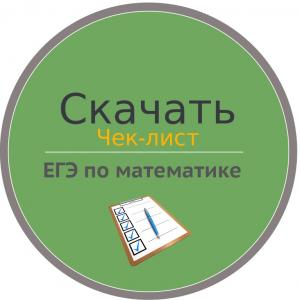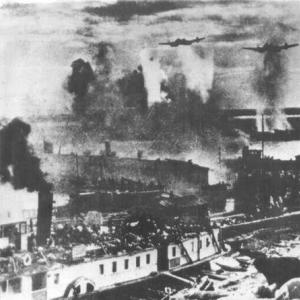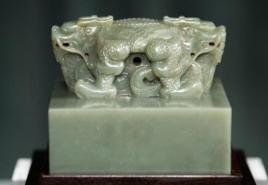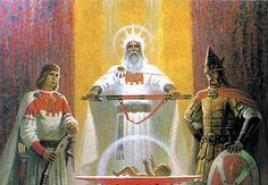Peter ivanovich Korostelev. Exhibition of paintings by People's Artist of Russia Petr Guryevich Korostelev Petr Korostelev
Korostelev Petr Ivanovich
Born in 1920 in the city of Belev, Tula Region, in the family of a hereditary railroad worker. Until 1940 he worked for rail transport... In 1940 he was drafted into the ranks of the Soviet Army. He participated in the Great Patriotic War against the German fascist invaders. Title of Hero Soviet Union assigned on October 23, 1943. He currently lives and works in Moscow.
Wave after wave of German dive bombers were advancing on the crossing, dropping bombs and shelling the units of the 161st Infantry Division crossing the river. But the soldiers of the unit stubbornly approached the shore.
Korostelev saw how our soldiers, beveled by the fire of fascist machine guns, fell on the shore.
Bastards beat from the flank! the sergeant guessed.
Korostelev found the regiment commander at the crossing.
They won't notice, you say? - Fedotov pondered the words of Pyotr Korostelev, glancing in the direction from which the Nazi machine gunners were firing.
The sergeant asked permission to cross the river with the squad a little to the right.
The attention of the Nazis, he said, is now riveted to the bulk of the forcing, and they will not pay attention to the separation. We'll go behind them and destroy the snipers and machine gunners.
Fedotov looked at the sergeant. Korostelev's face was courageous and resolute. The sergeant waited for an answer, but the lieutenant colonel hesitated.
Do you understand the risk you are taking? the regiment commander suddenly asked. - If they find you, they will shoot you like chickens.
In war, everyone risks ...
Fedotov watched as a group of daredevils separated from the shore. They sailed, it seemed, very slowly. The regimental commander was nervous: "You wouldn't have noticed." He ordered a mortar platoon, if necessary, to support the squad with fire.
The Nazis opened fire on Korostelev's group when there was already a little left to the coast. Soon the group took cover behind the steep slope of the right bank, enemy bullets no longer reached it.
You can't go to the left, the Germans think that we are going to get closer to ours at the crossing, ”the sergeant decided. And the squad went to the right, and then began to climb up the steep slope.
The sergeant crawled first. Soldiers followed him.
Ooh, bastard! - I heard from behind.
What is there? - asked the squad leader, stopping for a minute.
Sniper.
A fascist was shooting behind one of the stones at the top of the cliff, a little to the left and closer to the crossing.
Do not open fire, do not reveal yourself. We will destroy it with a knife, - Peter Korostelev ordered.
One soldier crawled to the sniper, who three minutes later froze forever on the Dnieper bank.
There are machine gunners at the high-rise, they interfere with the crossing, - the sergeant explained. - Behind me! - The soldiers rushed after the sergeant.
The daredevils saw the pressure of the forcing. We saw how fascist mines and shells burst in their midst, how a soldier mowed down the fire of German machine-gunners who sat at the height.
Squad, attack! - could not stand Korostelev and the first rushed to the high-rise.
The blow from the rear caught the fascists by surprise. Grenades flew into their trenches.
The high-rise has been cleared of the enemy. Fascist machine gunners were lying dead. And below on the river, to the western bank, now no longer fired by the enemy, rafts and boats with our soldiers sailed.
Sergeant Korostelev, to the regiment commander! - called Peter.
Comrade Lieutenant Colonel, - the sergeant began to report on the arrival, but Fedotov interrupted him:
Congratulations on your success! The Tula will be proud of you.
A quarter of an hour later, Pyotr Korostelev was marching in the battle formations of units, ready for new battles with the enemy.
From the book of 100 Great Military Leaders author Shishov Alexey VasilievichPETER I THE GREAT (PETER I ALEKSEEVICH ROMANOV) 1672-1725 The last Russian tsar and the first Russian emperor. A commander, founder of the Russian regular army and navy, the youngest son of Tsar Alexei Mikhailovich from his second marriage to N.K. Naryshkina received a home education. Special role
From the book Temporary workers and favorites of the 16th, 17th and 18th centuries. Book II author Birkin KondratyBAGRATION PETR IVANOVICH 1765-1812 Prince. General of Infantry. Hero Patriotic War 1812, student and associate of A.V. Suvorov and M.I. Kutuzov. Pyotr Ivanovich Bagration was born in the North Caucasus, in Kizlyar. Descended from an old Georgian princely family, in which
From the book In the Name of the Motherland. Stories about Chelyabinsk citizens - Heroes and twice Heroes of the Soviet Union author Ushakov Alexander ProkopyevichDMITRY IVANOVICH (SAMOZVANETS) KSENIYA BORISOVNA GODUNOVA. - PETER BASMANOV (1605–1606) to Boris Godunov, comparatively speaking, the throne was more accessible: he grew up at court, knew how to win the favor of Ivan the Terrible, become related to his family; could gradually, step by step get closer
From the book of A. S. Ter-Ohanyan: Life, Fate and Contemporary Art author Nemirov Miroslav MaratovichKAZAKOV Petr Ivanovich Petr Ivanovich Kazakov was born in 1909 in the village of Sukhteli, Verkhneuralsky district Chelyabinsk region in a peasant family. Russian. In 1933 he moved to Magnitogorsk. He worked as a switchman, and then as a duty officer at a railway station
From the book White Front by General Yudenich. Biographies of the ranks of the North-Western Army author Rutych Nikolay NikolaevichPeter I We strongly condemn A.S. Ter-Ohanyan for his lack of perseverance, because he first started to fight in the south, Azov, Taganrog. And the capital - at first I wanted to move it there! - considers Ohanyan. - And how much different would be
From the book of 50 famous cranks author Sklyarenko Valentina MarkovnaPetr Ivanovich Ivanov, Major General Born on January 21, 1866 in the city of Derbent. Armenian-Grego-Rian faith. Studied (did not graduate) at the Baku real school. In 1884 he entered the 1st Caucasian reserve battalion as a volunteer. In 1888 he graduated from Tiflis
From the book of Dahl author Vladimir Ilyich PorudominskiySHALIKOV (SHALIKASHVILI) PETR IVANOVICH (born in 1768 - died in 1852) Prince, poet, translator and journalist, subject of parodies and ridicule, who was nicknamed "Sighs" by his contemporaries. At the same time, Shalikov was a man who was truly (albeit in his own way) devoted
From the book of 50 famous murders author Fomin Alexander VladimirovichVLADIMIR IVANOVICH AND OSIP IVANOVICH 1But there was also Osip Ivanovich ... There was Osip Ivanovich, a small official (and small in stature, with a heavy hump behind his back) - a scribe; by position - a scribe, but most importantly - a scribe sculpted by life. After all, some chinishki went for him
From the book Field Marshals in the History of Russia author Rubtsov Yuri ViktorovichPETER III German prince Karl-Peter-Ulrich - son of Duke of Holstein-Gottorp Karl Friedrich and Anna Petrovna, grandson of Peter I. He moved to Russia in 1742 at the insistence of Elizabeth Petrovna. Russian emperor since 1761. Overthrown as a result of a coup organized by him
From the book The Path to Chekhov author Gromov Mikhail PetrovichCount Pyotr Ivanovich Shuvalov (1710–1762) Pyotr Ivanovich - the younger brother of Field Marshal A.I. Shuvalov. FROM early years he got to the royal court, so that he had the opportunity to study court customs and learn how to put them in his service. In the beginning was a page
From the book Tulyaki - Heroes of the Soviet Union author Apollonova A.M.Kurkin Pyotr Ivanovich (1858-1934) A doctor familiar with Chekhov since student years and corresponded with him for the rest of his life. In the 1890s he was a zemstvo doctor in Serpukhov. “Tolstoy calls us scoundrels,” Chekhov wrote to A.S. Suvorin on October 27, 1892, “and I am positively convinced,
From the book Soldier's Valor author Vaganov Ivan MaksimovichKuznetsov Petr Ivanovich Born in 1925 in the village of Zelenye Luzhki, Suvorov District, Tula Region. In 1941 he graduated from seven classes of Likhvinskaya (now Chekalinskaya) high school... He worked on a collective farm. In 1942 he was drafted into the ranks of the Soviet Army. Title of Hero of the Soviet Union
From the book The Silver Age. Portrait gallery of cultural heroes of the turn of the XIX-XX centuries. Volume 1. A-I author Fokin Pavel EvgenievichPOSPELOV PETR IVANOVICH A group of artillery reconnaissance spotters received the task to penetrate the enemy's rear, find guns there, which are firing destructive fire at our troops. The search group led by Lieutenant Zolotarev leaked through
From the book The Silver Age. Portrait gallery of cultural heroes at the turn of the XIX-XX centuries. Volume 3.S-Z author Fokin Pavel Evgenievich20.01.1921 - 13.08.2004
Hero of the Soviet Union
Korostelev Pyotr Ivanovich - squad leader of the 569th infantry regiment (161st rifle division, 40th Army, Voronezh Front), sergeant.
Born on January 20, 1921 in the city of Belyov, Belevsky district, Tula province (now the regional center of the Tula region). Russian. He graduated from the 6th grade of the school. He worked as a mechanic in a mechanical workshop and as an assistant driver at the Belyov railway depot.
In the army since May 1940. He served in the NKVD troops; guarded important objects in Kiev.
Member of the Great Patriotic War since August 1941 as part of a separate battalion of the NKVD. Participated in the defense of Kiev. In September 1941, while mining objects in Kiev, he was surrounded, from which he managed to get out to his own.
From July 1942 - commander of the scout squad of the 569th Infantry Regiment (Voronezh Front). He participated in defensive battles north of Voronezh, Ostrogozh-Rossosh, Voronezh-Kastornenskaya, Kharkov offensive and defensive, Belgorod-Kharkov and Sumy-Priluki operations, the battle for the Dnieper.
Particularly distinguished himself when crossing the Dnieper. On September 23, 1943, he was among the first to cross the river near the village of Zarubintsy (Kanevsky District, Cherkasy Region, Ukraine). Having seized a bridgehead on the western bank of the Dnieper, the soldiers of the squad under his command destroyed enemy firing points, which contributed to the crossing of the river by other units of the regiment. In the battles to capture and hold the bridgehead, he personally destroyed dozens of Nazis, took an officer prisoner. In critical moments of the battle, he repeatedly raised the soldiers in a bayonet attack. In subsequent battles, he was seriously wounded, contused and sent to the rear hospital.
For courage and heroism shown in battles with german fascist invaders, By the decree of the Presidium of the Supreme Soviet of the USSR dated October 23, 1943 to the sergeant Peter Ivanovich Korostelyov awarded the title of Hero of the Soviet Union with the award of the Order of Lenin and the medal " Golden Star».
In 1945 Sergeant Major P.I. Korostelev was demobilized. In 1946 he graduated from courses at the Moscow Institute of Transport Engineers. He worked as a senior engineer of the locomotive economy of the Paveletsky direction in Moscow, in 1947-1985 - as a train manager.
Honored Transport Worker of the RSFSR (1980). He was awarded the Orders of Lenin (23.10.1943), the Order of the Patriotic War of the 1st degree (11.03.1985), the Order of the Red Banner of Labor, and medals.
In the city of Belyov, a memorial plaque is installed on the house in which he was born and lived.
Note: Reliable information about the future combat path absent.
Sources
Their lofty feat is immortal. - Tula: Priokskoe book. ed., 1983 Vorobiev V.P., Efimov N.V. Heroes of the Soviet Union: ref. - St. Petersburg, 2010. Heroes of the Soviet Union: krat. biogr. words. Vol. 1. - Moscow, 1987. Hero-liberators of the Cherkasy region. - Dnepropetrovsk: Promin, 1980 Documents on the site "
"Seeing the character ..."
This is how the painter Pyotr Guryevich Korostelev expresses his attitude to the portrait. But this is essentially the creative principle of the artist in relation to any genre in which he works. To a genre and historical picture, a landscape, as a rule, organically included in thematic compositions, to a still life, very diverse in plot and pictorial intonations. And everywhere, in any genre and work, he is looking for a unique character that defines the image, for indeed “Art is a piece thing,” as one of Korostelev's favorite artists, Evsey Evseevich Moiseenko, said.
Filled with the artist's talent, these qualities are realized in their own way in creativity: in the approach to the model, nature, the true measure of what he saw and wrote. That is why the works with the characteristic addition to the title "From my childhood" are not accidental. She kept her memory tenaciously, and her profession “cut off” the impressions of the mowing work, the sight of a brooding river in the gentle banks, relatives, from the familiar objects that appeared later in the form of firmly written, densely painted “village” still lifes or landscapes. Such impressions are not forgotten, but they grow by what they see, developed ability "To look and see", to transform prose into poetry.
Such a transformation was taught by Korosteleva, a teacher at the Penza Art School I.S. Goryushkin-Skoropudov, and his art colleagues. They taught the traditions of V.E. Borisov-Musatov and K.S. Petrov-Vodkin. Paul Cezanne and Henri Matisse, representatives of the "Union of Russian Artists" and "Jack of Diamonds" ... He taught everything that was fused by his own vision into his own style. By no means canonical, knowing both the strength of the pasty brushstroke, and the compactness of the form, the thickening of the color and its obvious luminosity, generalization with the accuracy of the pictorial drawing, authentic objectivity and convincing decorativeness.
The artist came to comprehend the importance of the components of the work during his studies in Leningrad, visiting the unique collections of the Hermitage and the Russian Museum. But before that there was a war, a severe injury, a difficult path to Victory. All this was reflected in works filled with pride in the great representatives of Russian culture, in an enduring desire to affirm the harmony and beauty that was achieved through suffering during the difficult and heroic war years. They exacerbated the patriotic feeling, brought to life pictures about the summit phenomena of the Russian genius - M. Glinka, A. Pushkin, M. Lermontov, I. Levitan, M. Mussorgsky, S. Yesenin ...
We recognize in the works of the painter our contemporaries: writer V. Shukshin, poet N. Rubtsov, artist B. Freindlich, professor P. Sukhanov, artists J. Krestovsky and B. Dalakyan, violist I. Grabko, pianist L. Grabko (the artist's wife) ... The painter's palette boldly connects the past with the present in the coordinates of times and events: “A. S. Pushkin and MI Glinka "," Komarinskaya ".
Their score is extremely expressive in terms of intonation, in its architectonics. There is a majestic as a palace "White Still Life" associated with the works of N. N. Sapunov, powerful plastic sounds impressive, close to the "Diamonds", captivates with a clear, pure melody of color, close to the muse of K. S. Petrov - Vodkin or elegiacity of V. E. Borisov - Musatova. These traditions were organically close to Korostelev's perception of the world, they acquired their own identity.
Is it not because the poetry of the artist, expressed in the words "to see character", is so clearly perceptible, which, in fact, is applicable not only to the portrait, where his credo is obvious, but also in all genres in which the painter appears. Individual uniqueness is in the faces of his characters: be it a peasant, musician, artist, historical hero or contemporary.
Still life in this series is no exception, rather an obvious example. You can fantasize: the staged space of the imaginary hall is filled only with still lifes - an impressive picture of beauty emerges. Here is "Lady with a Bouquet of Flowers", where a person and flowers make up a single image. "Still life with a white vase", as if permeated with a stream of silvery strokes; exquisite sharpness of forms, a combination of brown and pearlescent tones "Still life with dry flowers", very dynamic in its structure. Still life with a samovar is distinguished by a powerful pictorial plastic of dense, hot tones, strong tense forms, as if contrasting with the strict, verified rhythms of Still Life on a Black Tablecloth, the impulsive writing of Still Life with Reeds, and the luminous, ringing like crystal, Still Life with a rural landscape ". I remember the words of the great Martiros Saryan: “The painter has the only opportunity to express his attitude to the world - in color”. Pyotr Korostelev, who has an outstanding coloristic talent, is very close to the definition of a master, an example is his art. P. G. Korostelev creates his world with his inherent passions, reflections, comprehension and discovery of beauty.
Petr Guryevich is an extremely kind person himself in his attitude to people, the ability to rejoice at the success of another, to understand him. And this is also a special talent, so noticeable, so tangible in creativity. Korostelev also has the closest environment of spiritual communication - his family, in which his wife, pianist Larisa Grabko, is also endowed with the well-known gift of a painter and special vital energy, which apparently gives impulses to Peter Guryevich, who is alien to "secular" communication. But the space of his creative touch is wide enough, embraces both the past and the present, is fed by earthly currents that convey the strength of life and artistic reliability. It was rightly said: "An artist ends when he ceases to be surprised." I have known Petr Korostelev for over forty years, I know his work. Therefore, I can say that now the artist continues.
Leading researcher at the State Russian Museum
Ph.D. in art history, professor
Anatoly Dmitrenko.
Tel. 323 64 96, 323 35 78.







